1998 CADILLAC ELDORADO dead battery
[x] Cancel search: dead batteryPage 124 of 380
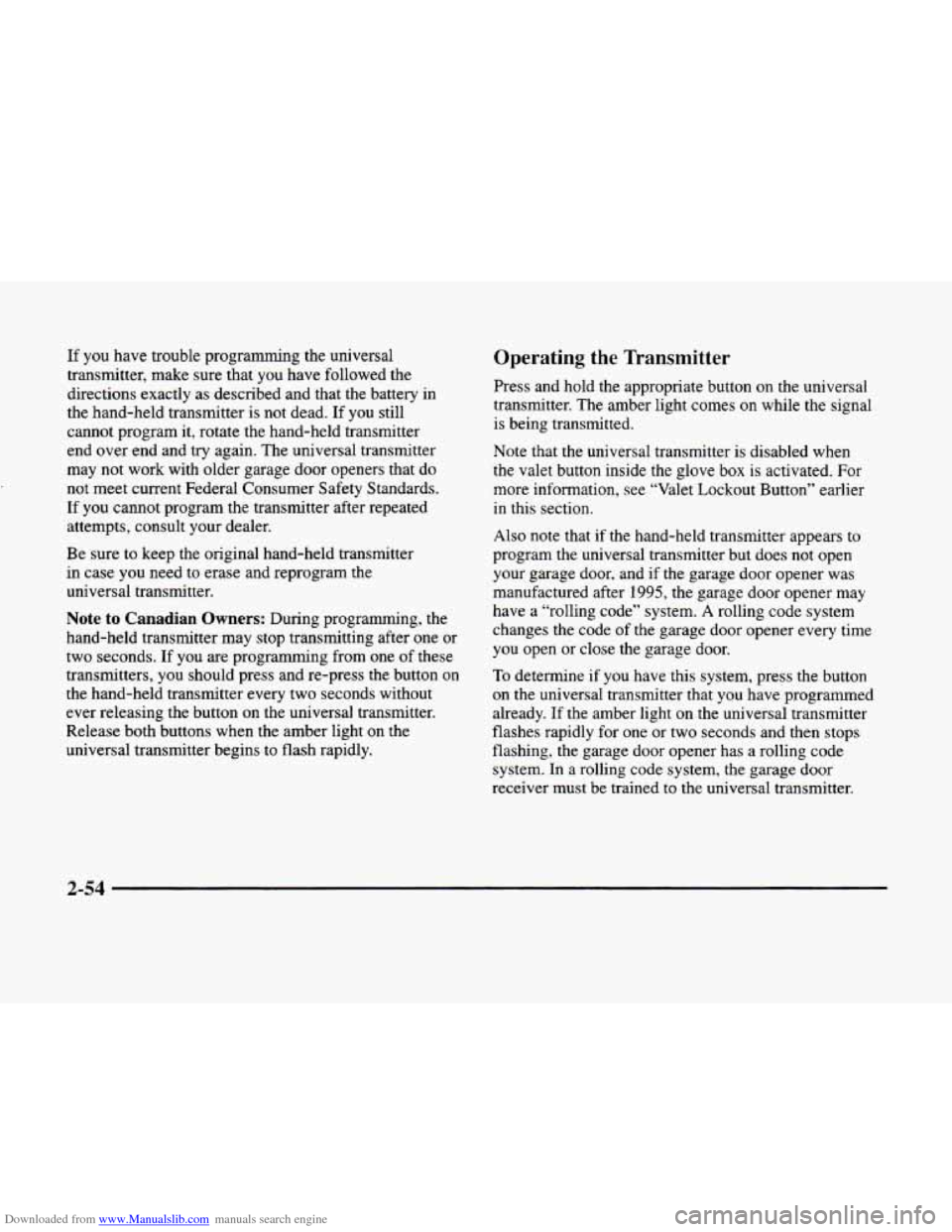
Downloaded from www.Manualslib.com manuals search engine If you have trouble programming the universal
transmitter, make sure that you have followed the
directions exactly as described and that the battery
in
the hand-held transmitter is not dead. If you still
cannot program it, rotate the hand-held transmitter
end over end and try again. The universal transmitter
may not work with older garage door openers that
do
not meet current Federal Consumer Safety Standards.
If you cannot program the transmitter after repeated
attempts, consult your dealer.
Be sure to keep the original hand-held transmitter
in case you need to erase and reprogram the
universal transmitter.
Note to Canadian Owners: During programming, the
hand-held transmitter may stop transmitting after one or
two seconds. If you are programming from one of these
transmitters, you should press and re-press the button
on
the hand-held transmitter every two seconds without
ever releasing the button
on the universal transmitter.
Release both buttons when the amber light on the
universal transmitter begins to flash rapidly.
Operating the Transmitter
Press and hold the appropriate button on the universal
transmitter. The amber light comes on while the signal
is being transmitted.
Note that the universal transmitter is disabled when
the valet button inside the glove box is activated. For
more information, see “Valet Lockout Button” earlier
in this section.
Also note that
if the hand-held transmitter appears to
program the universal transmitter but does not open
your garage door, and
if the garage door opener was
manufactured after
1995, the garage door opener may
have a “rolling code” system.
A rolling code system
changes the code of the garage door opener every time
you open or close the garage door.
To determine if you have this system, press the button
on the universal transmitter that you have programmed
already.
If the amber light on the universal transmitter
flashes rapidly for one or two seconds and then stops
flashing, the garage door opener has
a rolling code
system. In a rolling code system, the garage door
receiver must
be trained to the universal transmitter.
Page 227 of 380
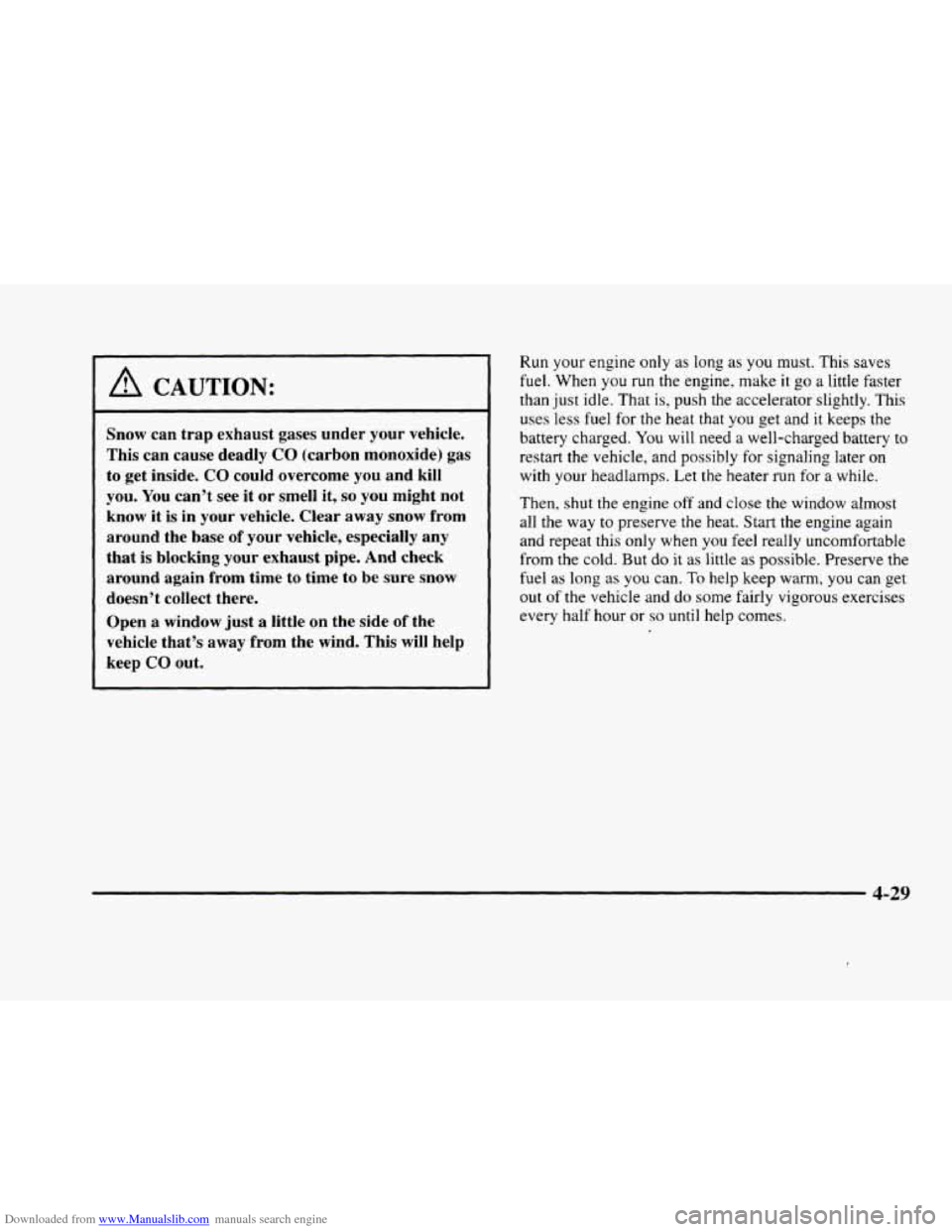
Downloaded from www.Manualslib.com manuals search engine I A CAUTION:
Snow can trap exhaust gases under your vehicle.
This can cause deadly
CO (carbon monoxide) gas
to get inside.
CO could overcome you and kill
you. You can’t see
it or smell it, so you might not
know it is in your vehicle. Clear
away snow from
around the base
of your vehicle, especially any
that is blocking your exhaust pipe.
And check
around again from time to time to be sure snow
doesn’t collect there.
Open a window just a
little on the side of the
vehicle that’s away from the wind.
This will help
keep
CO out.
Run your engine only as long as you must. This saves
fuel. When you run the engine. make it go a little faster
than just idle. That is, push the accelerator slightly. This
uses less
fuel for the heat that you get and it keeps the
battery charged.
You will need a well-charged battery to
restart the vehicle, and possibly for signaling later on
with your headlamps. Let the heater run for
a while.
Then, shut
the engine off and close the window almost
all the way
to preserve the heat. Start the engine again
and repeat this
only when you feel really uncomfortable
from the cold. But do it as little
as possible. Preserve the
fuel as long
as you can. To help keep warm, you can get
out of the vehicle and
do some fairly vigorous exercises
every half hour or
so until help comes.
4-29
Page 246 of 380
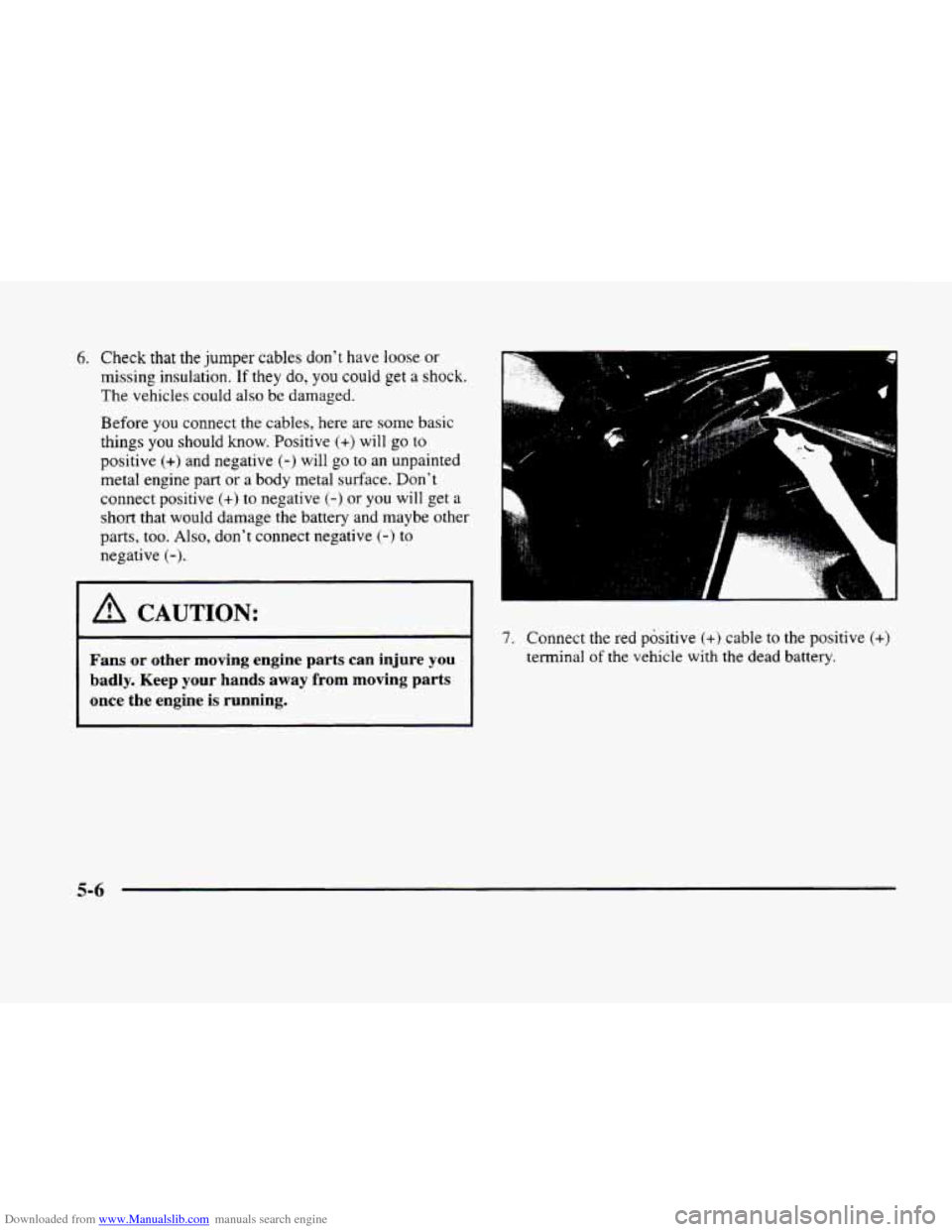
Downloaded from www.Manualslib.com manuals search engine 6. Check that the jumper cables don't have loose or
missing insulation. If they do, you could get a shock.
The vehicles could also be damaged.
Before you connect the cables, here are some basic
things
you should know. Positive (+) will go to
positive (+) and negative (-) will go to an unpainted
metal engine part
or a body metal surface. Don't
connect positive
(+) to negative (-) or you will get a
short that would damage the battery and maybe other
parts, too. Also, don't connect negative
(-) to
negative
(-).
I A CAUTION:
7. Connect the red positive (+) cable to the positive (+>
Fans or other moving engine parts can injure you
badly. Keep your hands away from moving parts
terminal of the vehicle with the dead battery.
once the engine is running.
5-6
Page 247 of 380
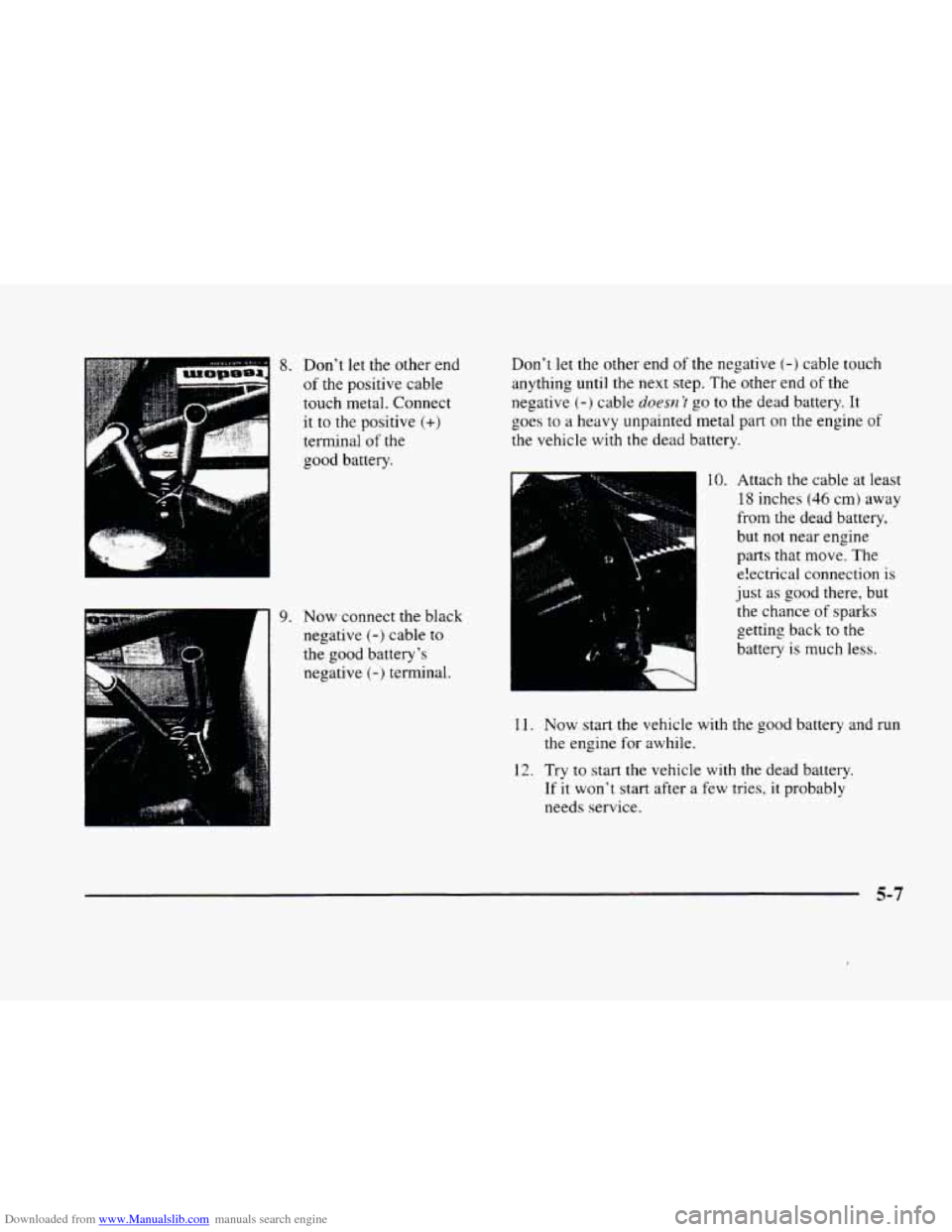
Downloaded from www.Manualslib.com manuals search engine , , ./
8. Don't let the other end
of the positive cable
touch metal. Connect
it to the positive
(+)
terminal of the
good battery.
9. Now connect the black
negative
(-) cable to
the good battery's
negative
(- j terminal. Don't let
the other end
of the negative (-) cable touch
anything until the next step. The other end
of the
negative
(-) cable duvsn 'I go to the dead battery. It
goes
to a heavy unpainted metal part on the engine of
the vehicle with the dead battery.
10. Attach the cable at least
18 inches (46 cm) away
from the dead battery,
but not near engine
parts
that move. The
electrical connection
is
just as good there, but
the chance
of sparks
getting back
to the
battery
is much less.
11. Now start the vehicle with the good battery and run
the engine for awhile.
12. Try to start the vehicle with the dead battery.
If
it won't start after a few tries, it probably
needs service.
5-7
Page 248 of 380
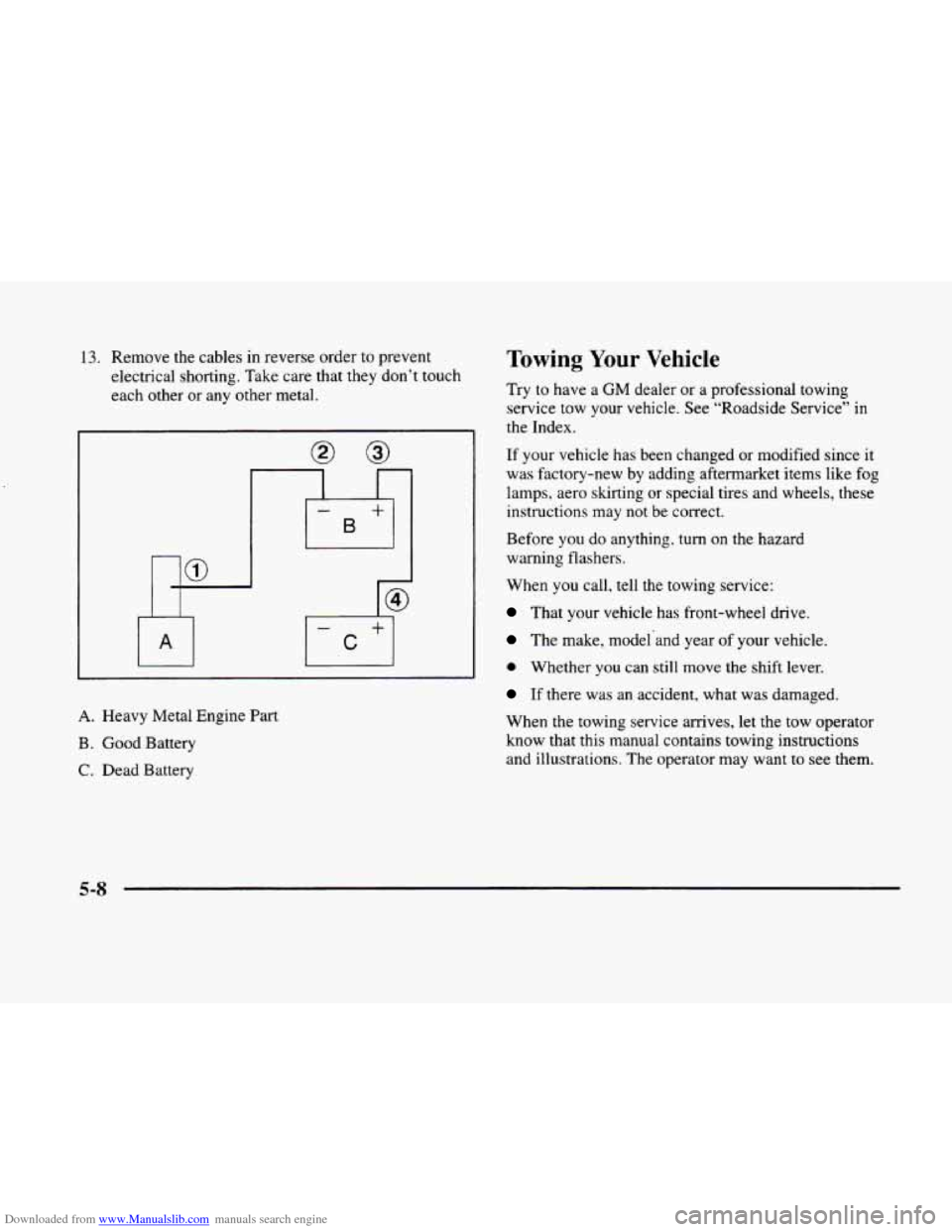
Downloaded from www.Manualslib.com manuals search engine 13. Remove the cables in reverse order to prevent
electrical shorting. Take care that they don’t touch
each other
or any other metal.
A. Heavy Metal Engine Part
B. Good Battery
C. Dead Battery
1
Towing Your Vehicle
Try to have a GM dealer or a professional towing
service tow your vehicle.
See “Roadside Service” in
the Index.
If your vehicle has been changed or modified since it
was factory-new by adding aftermarket items like fog
lamps, aero skirting
or special tires and wheels, these
instructions may not be correct.
Before
you do anything, turn on the hazard
warning flashers.
When you call, tell the towing service:
That your vehicle has front-wheel drive.
The make, model’and year of your vehicle.
0 Whether you can still move the shift lever.
If there was an accident, what was damaged.
When the towing service arrives, let the tow operator
know that this manual contains towing instructions
and illustrations.
The operator may want to see them.
Page 365 of 380

Downloaded from www.Manualslib.com manuals search engine Cleaning Alummum or Chrome Wheels
................... 6-52
Fabric
...................................... 6-48
Glass
....................................... 6-50
Inside
of Your Vehicle ......................... 6-47
Instrument Panel
............................. 6-49
Leather
..................................... 6- 49
Outside
of Your Vehicle ........................ 6-50
Speakercovers .............................. 6-49
Special Problems
............................. 6-48
Stains
................................. 6.48. 6.49
Tires
....................................... 6-52
Vinyl
....................................... 6-48
Wheels
..................................... 6-52
Windshield and Wiper Blades
................... 6-50
WoodPanels
................................. 6-49
Climate Control Panel
............................ 3-2
Climate Control Personalization
.................... 3-9
Climate Control
. Steering Wheel Controls ............ 3-9
Climate Control System
........................... 3-2
Clock . Setting the ................................ 3-9
Comfort Controls
................................ 3-2
Compact Disc Care ............................. 3-36
Compact Disc Player
....................... 3-17. 3-26
Cornpact Disc Player Errors .................. 3- 17. 3.26
Compact Spare
Tire ............................. 5-34
Console Shift Lever ............................. 2-26
Continuous Variable
- Road Sensing Suspension ...... 2-84
Control
of a Vehicle .............................. 4-6
Convenience Net
............................... 2-50
Convex Outside Mirror
.......................... 2-48
Compass
. Rearview Mirror
with ................... 2-45 Coolant
................................ ?. 6-22, 6-23
Heater, Engine
............................... 2-20
SurgeTank .................................. 5-20
Cooling System ................................
Damage. Finish ............................... 6-52
Damage . Sheet Metal ............................ 6-52
Daytime Running Lamps
......................... 2-40
Dead Battery
................................... 5-3
Defects. Reporting Safety ................... 7- 12. 7- 13
Defensive Driving ................................ 4-2
Defogger. Rear Window
.......................... 3-8
Defrosting ..................................... 3-8
Digital Control Buttons .......................... 2-70
Dimensions, Vehicle ............................ 6-64
Dolby
B Noise Reduction .............. 3-1 3. 3- 16. 3-25
Door Central Unlocking System
....................... 2-4
MapPocket
................................. 2-49
OpenMessage
............................... 2-73
Driver Door Open Message
....................... 2-73
DIC .......................................... 2-70
Locks ....................................... 2-4
.. ~ .. 8-3